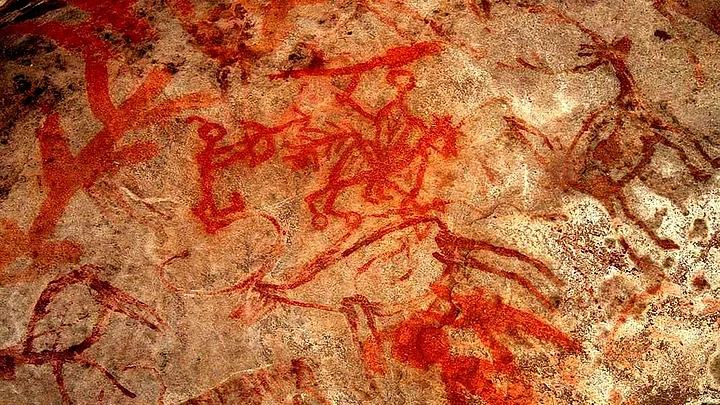(This excerpt has been taken with permission from ‘Early Indians: The Story of Our Ancestors and Where We Came From’ by Tony Joseph, published by Juggernaut. The book is available on Amazon.in)
If you want to get as close as possible to the lives of the first modern humans in India, one of the best places to go to is Bhimbetka in Madhya Pradesh’s Raisen district, about forty-five kilometres from the state capital, Bhopal. It is an enchanting place spread over seven hills and full of naturally occurring rock shelters that are perhaps more imposing and majestic than most man-made residences of the twenty-first century. Th ere are perennial springs, creeks and streams filled with fish; plenty of fruits, tubers and roots; deer, boar and hare; and, of course, as many quartzite rocks as you need to make all the tools you want. Moreover, the elevation of the hills makes it possible for the residents to keep track of who is approaching them: food or predator, nilgai or leopard!
In the world of early humans, this must have been the equivalent of a much sought-after luxury resort. Ever since it was first occupied some 100,000 years ago, it has never lain vacant for too long, and it is easy to imagine there having been a long waiting list to get in. A place so well liked that millennia after millennia, one or the other Homo species, including our own ancestors, the Homo sapiens, lived and hunted and painted and partied there. Yes, the rock shelters are full of paintings, including some that depict people dancing to drumbeats. The paintings are not well-dated, so it is quite likely that most of them, though not all, were made within the last few thousand years, rather than many tens of thousands of years ago. But there are a few petroglyphs, or rock carvings or markings, that could be the earliest evidence of art created by members of the Homo species anywhere in the world – a few perfect cupules (small cup-like depressions) with lines beside them.
But do we know exactly when the first modern humans set foot in Bhimbetka or, for that matter, in India? The answer to that is a bit complex. First we need to define what we mean when we say ‘first modern humans in India’. The technical meaning of the phrase would be any individual belonging to the Homo sapiens species who set foot in India first. However, when we say ‘first modern humans in India’ we also often mean to say the earliest direct ancestors of people living in India today. It is important to know that there is a difference between the two.
For example, let us say the first Homo sapiens in India were a group of thirty people in Bhimbetka 80,000 years ago. Let us also say that some calamity – like the huge Toba supervolcanic eruption that occurred in Sumatra, Indonesia, 74,000 years ago and impacted the entire region from east Asia to east Africa – directly or indirectly killed off every one of this first group of modern humans, leaving behind no one to populate the subcontinent. Let us then imagine a second group of modern humans in Bhimbetka around 50,000 years ago, who successfully settle down and leave behind a lineage of people still found in India. Are we referring to the second group when we say the ‘first modern humans in India’? Th is may look like a matter of semantics and it is so, in a way, but it has meaningful implications for us when we interpret archaeological or other evidence to understand the history of early Indians.
If you ask Indian archaeologists when the first modern humans arrived in India, at least some of them are likely to put a date that is perhaps as early as 120,000 years ago. But if you ask a population geneticist, that is, a geneticist studying genetic variations within and between population groups, the answer is likely to be around 65,000 years or so ago. Th is seemingly irreconcilable difference between the two sciences is not necessarily contradictory. When geneticists talk about the first modern humans in India, they mean the first group of modern humans who have successfully left behind a lineage that is still around. But when archaeologists talk about the first modern humans in India, they are talking about the first group of modern humans who could have left behind archaeological evidence that can be examined today, irrespective of whether or not they have a surviving lineage.
